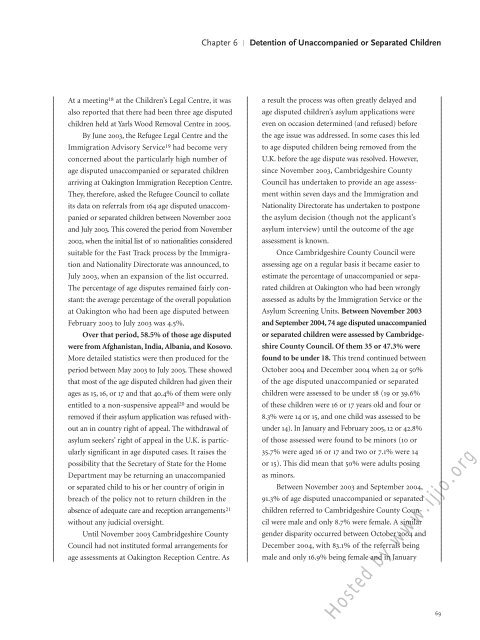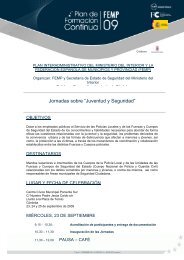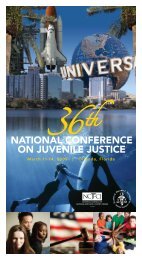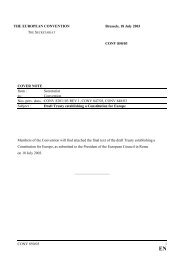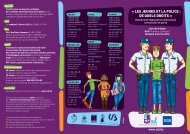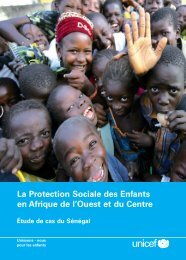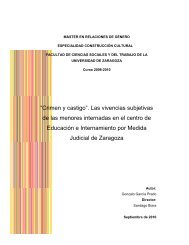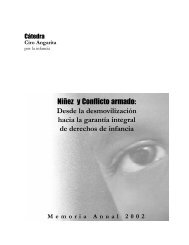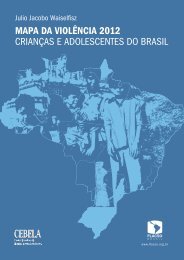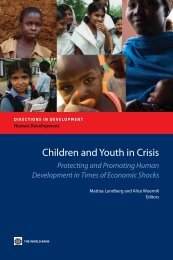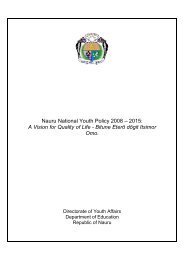Hosted by www.ijjo.org
Hosted by www.ijjo.org
Hosted by www.ijjo.org
Create successful ePaper yourself
Turn your PDF publications into a flip-book with our unique Google optimized e-Paper software.
Chapter 6 | Detention of Unaccompanied or Separated Children<br />
At a meeting 18 at the Children’s Legal Centre, it was<br />
also reported that there had been three age disputed<br />
children held at Yarls Wood Removal Centre in 2005.<br />
By June 2003, the Refugee Legal Centre and the<br />
Immigration Advisory Service 19 had become very<br />
concerned about the particularly high number of<br />
age disputed unaccompanied or separated children<br />
arriving at Oakington Immigration Reception Centre.<br />
They, therefore, asked the Refugee Council to collate<br />
its data on referrals from 164 age disputed unaccompanied<br />
or separated children between November 2002<br />
and July 2003. This covered the period from November<br />
2002, when the initial list of 10 nationalities considered<br />
suitable for the Fast Track process <strong>by</strong> the Immigration<br />
and Nationality Directorate was announced, to<br />
July 2003, when an expansion of the list occurred.<br />
The percentage of age disputes remained fairly constant:<br />
the average percentage of the overall population<br />
at Oakington who had been age disputed between<br />
February 2003 to July 2003 was 4.5%.<br />
Over that period, 58.5% of those age disputed<br />
were from Afghanistan, India, Albania, and Kosovo.<br />
More detailed statistics were then produced for the<br />
period between May 2003 to July 2003. These showed<br />
that most of the age disputed children had given their<br />
ages as 15, 16,or 17 and that 40.4% of them were only<br />
entitled to a non-suspensive appeal 20 and would be<br />
removed if their asylum application was refused without<br />
an in country right of appeal. The withdrawal of<br />
asylum seekers’ right of appeal in the U.K. is particularly<br />
significant in age disputed cases. It raises the<br />
possibility that the Secretary of State for the Home<br />
Department may be returning an unaccompanied<br />
or separated child to his or her country of origin in<br />
breach of the policy not to return children in the<br />
absence of adequate care and reception arrangements 21<br />
without any judicial oversight.<br />
Until November 2003 Cambridgeshire County<br />
Council had not instituted formal arrangements for<br />
age assessments at Oakington Reception Centre. As<br />
a result the process was often greatly delayed and<br />
age disputed children’s asylum applications were<br />
even on occasion determined (and refused) before<br />
the age issue was addressed. In some cases this led<br />
to age disputed children being removed from the<br />
U.K. before the age dispute was resolved. However,<br />
since November 2003, Cambridgeshire County<br />
Council has undertaken to provide an age assessment<br />
within seven days and the Immigration and<br />
Nationality Directorate has undertaken to postpone<br />
the asylum decision (though not the applicant’s<br />
asylum interview) until the outcome of the age<br />
assessment is known.<br />
Once Cambridgeshire County Council were<br />
assessing age on a regular basis it became easier to<br />
estimate the percentage of unaccompanied or separated<br />
children at Oakington who had been wrongly<br />
assessed as adults <strong>by</strong> the Immigration Service or the<br />
Asylum Screening Units. Between November 2003<br />
and September 2004, 74 age disputed unaccompanied<br />
or separated children were assessed <strong>by</strong> Cambridgeshire<br />
County Council. Of them 35 or 47.3% were<br />
found to be under 18. This trend continued between<br />
October 2004 and December 2004 when 24 or 50%<br />
of the age disputed unaccompanied or separated<br />
children were assessed to be under 18 (19 or 39.6%<br />
of these children were 16 or 17 years old and four or<br />
8.3% were 14 or 15, and one child was assessed to be<br />
under 14). In January and February 2005, 12 or 42.8%<br />
of those assessed were found to be minors (10 or<br />
35.7% were aged 16 or 17 and two or 7.1% were 14<br />
or 15). This did mean that 50% were adults posing<br />
as minors.<br />
Between November 2003 and September 2004,<br />
91.3% of age disputed unaccompanied or separated<br />
children referred to Cambridgeshire County Council<br />
were male and only 8.7% were female. A similar<br />
gender disparity occurred between October 2004 and<br />
December 2004, with 83.1% of the referrals being<br />
male and only 16.9% being female and in January<br />
<strong>Hosted</strong> <strong>by</strong> <strong>www</strong>.<strong>ijjo</strong>.<strong>org</strong><br />
69


